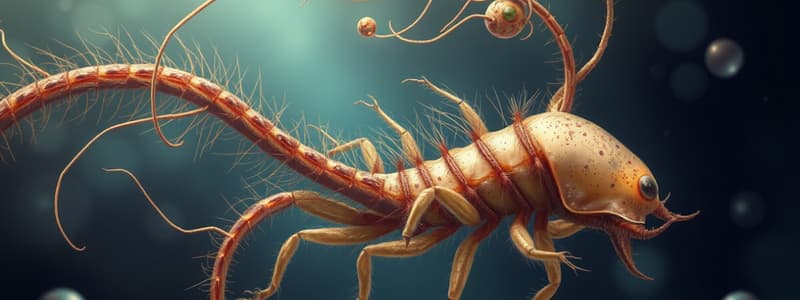Podcast
Questions and Answers
Who is considered the father of Parasitology?
Who is considered the father of Parasitology?
- Entamoeba histolytica
- Platter (correct)
- Francesco Redi
- Echinococcus granulosus
Which branch of Parasitology focuses on the structure of proteins from parasites?
Which branch of Parasitology focuses on the structure of proteins from parasites?
- Helminthology
- Structural Parasitology (correct)
- Protozology
- Quantitative Parasitology
What is an example of a protozoan studied in Veterinary Protozology?
What is an example of a protozoan studied in Veterinary Protozology?
- Leishmania
- Ascaridia galli
- Taenia solium
- Coccidia (correct)
Piroplasmosis is caused by which protozoan?
Piroplasmosis is caused by which protozoan?
Which type of organism is the focus of Helminthology?
Which type of organism is the focus of Helminthology?
Which branch deals with the statistical study of parasites?
Which branch deals with the statistical study of parasites?
Which of the following parasites falls under the category of Nematodes?
Which of the following parasites falls under the category of Nematodes?
Leishmaniasis is caused by which protozoan?
Leishmaniasis is caused by which protozoan?
What is defined as a wrong host species for a parasite?
What is defined as a wrong host species for a parasite?
Which of the following is an example of a mutualistic relationship?
Which of the following is an example of a mutualistic relationship?
What type of symbiotic relationship involves one organism benefiting at the expense of another?
What type of symbiotic relationship involves one organism benefiting at the expense of another?
What does the term 'phoresis' mean in the context of symbiotic relationships?
What does the term 'phoresis' mean in the context of symbiotic relationships?
Which type of relationship is characterized by one organism receiving all the benefits while the other is neither helped nor harmed?
Which type of relationship is characterized by one organism receiving all the benefits while the other is neither helped nor harmed?
Which statement correctly defines commensalism?
Which statement correctly defines commensalism?
What defines a parasitic relationship in symbiosis?
What defines a parasitic relationship in symbiosis?
In a predator-prey relationship, which term refers to the smaller or weaker animal?
In a predator-prey relationship, which term refers to the smaller or weaker animal?
What prevents viable eggs in the stool or urine of infected persons from being infective for humans in certain countries?
What prevents viable eggs in the stool or urine of infected persons from being infective for humans in certain countries?
Which harmful effect of parasites can lead to secondary infections?
Which harmful effect of parasites can lead to secondary infections?
What specifically characterizes a direct life cycle of a parasite?
What specifically characterizes a direct life cycle of a parasite?
Which of the following is an example of a parasite that is species specific?
Which of the following is an example of a parasite that is species specific?
What is one effect of parasite vectors?
What is one effect of parasite vectors?
What is a biological vector in relation to parasites?
What is a biological vector in relation to parasites?
Which of the following is an example of a mechanical vector?
Which of the following is an example of a mechanical vector?
What characteristic defines parasitic nutrition?
What characteristic defines parasitic nutrition?
Why are parasites dependent on their hosts?
Why are parasites dependent on their hosts?
What role do environmental constraints play in the transmission of diseases?
What role do environmental constraints play in the transmission of diseases?
What is one example of a disease transmitted by ticks?
What is one example of a disease transmitted by ticks?
How does the malaria parasite primarily impact humans?
How does the malaria parasite primarily impact humans?
Which disease is NOT listed as being transmitted by mosquitoes?
Which disease is NOT listed as being transmitted by mosquitoes?
What is the primary focus of veterinary entomology?
What is the primary focus of veterinary entomology?
Which type of parasite must lead a parasitic existence and lacks free-living stages?
Which type of parasite must lead a parasitic existence and lacks free-living stages?
Which example correctly identifies a definitive host?
Which example correctly identifies a definitive host?
What characterizes an ectoparasite?
What characterizes an ectoparasite?
Which of the following is NOT a type of parasite based on location on the host?
Which of the following is NOT a type of parasite based on location on the host?
Which type of parasite is considered a pseudoparasite?
Which type of parasite is considered a pseudoparasite?
Which of the following correctly describes an intermediate host?
Which of the following correctly describes an intermediate host?
What is a characteristic of a facultative parasite?
What is a characteristic of a facultative parasite?
What type of interaction with the host is NOT a potential pathogenesis caused by parasites?
What type of interaction with the host is NOT a potential pathogenesis caused by parasites?
Which of the following is a characteristic of permanent parasites?
Which of the following is a characteristic of permanent parasites?
What is the primary difference between temporary and stationary parasites?
What is the primary difference between temporary and stationary parasites?
Which is NOT a phylum that contains parasites discussed in the content?
Which is NOT a phylum that contains parasites discussed in the content?
How are incidental parasites defined?
How are incidental parasites defined?
Which of the following is an example of an endoparasite?
Which of the following is an example of an endoparasite?
Flashcards are hidden until you start studying
Study Notes
Parasitology Overview
- Parasitology studies the relationship between parasites and their hosts.
- Platter is recognized as the Father of Parasitology; Francesco Redi is considered the Father of Modern Parasitology.
Branches of Parasitology
- Structural Parasitology: Focuses on parasitic protein structures to aid drug discovery.
- Quantitative Parasitology: Utilizes statistics to analyze the distribution of parasitic infections among hosts.
- Protozoology: Scientific study of protozoa, unicellular eukaryotes, exemplified by Coccidia.
- Helminthology: Studies parasitic worms, including nematodes, trematodes, and cestodes, like Echinococcus granulosus.
- Entomology: Studies insects as vectors of diseases, with examples like Aedes albopictus (mosquito).
Types of Protozoa
- Veterinary Protozoology: Examines protozoa causing animal diseases, such as Piroplasmosis from Babesia equi.
- Medical Protozoology: Investigates protozoa affecting humans, such as Entamoeba histolytica causing amoebiasis.
Helminths
- Veterinary Helminthology: Studies parasites like Ascaridia galli affecting birds and Fasciola hepatica in ruminants.
- Medical Helminthology: Focuses on human-affecting helminths like Ascaris lumbricoides.
Parasite Taxonomy
- Kingdom Protista: Includes single-celled organisms like Amoeba and Toxoplasma.
- Kingdom Animalia: Majority of discussed parasites are multicellular, including phyla Platyhelminthes, Archelminthes, and Arthropoda.
Classification Based on Host Interaction
- Ectoparasites: Live on the outside of hosts (e.g., fleas).
- Endoparasites: Reside inside hosts (e.g., roundworms).
Duration on Host
- Temporary Parasites: Visit hosts for food (e.g., ticks).
- Stationary Parasites: Spend a definitive period on hosts.
- Permanent Parasites: Live on hosts throughout their life cycle.
Types of Parasites
- Incidental Parasite: Found in unusual hosts (e.g., heartworms in humans).
- Erratic Parasite: Abnormal locations in hosts (e.g., heartworm in the eye).
- Obligate Parasite: Must live parasitically, no free-living stage (e.g., lice).
- Facultative Parasite: Can be free-living or parasitic (e.g., ringworm).
- Pseudoparasite: False parasites (e.g., pollen grains).
Host Types
- Definitive Host: Where the parasite completes its sexual cycle (e.g., mosquitoes for malaria).
- Intermediate Host: Where the parasite replicates but does not undergo sexual reproduction.
- Reservoir Hosts: Carry parasites without significant impact on humans (e.g., rabies in wild mammals).
- Incidental/Accidental Host: Wrong host species for a parasite (e.g., heartworms in cats).
Symbiotic Relationships
- Symbiosis: Mutual association between different organisms.
- Types of Associations:
- Predator-Prey: One benefits at the other's expense.
- Phoresis: One organism is carried by another without dependency.
- Commensalism: One benefits while the other is unaffected.
- Mutualism: Both benefit.
- Parasitism: One benefits at the expense of the other.
Disease Vectors
- Biological Vectors: Parasite undergoes stages within the vector (e.g., Plasmodium in mosquitoes).
- Mechanical Vectors: Transport parasites without undergoing life stages (e.g., flies carrying pathogens).
Parasitic Nutrition
- Parasites obtain nutrients directly from hosts, often harming them in the process.
Environmental Constraints on Transmission
- Availability of intermediate hosts can restrict geographical spread of parasites, e.g., schistosomiasis is not found without specific snail hosts.
Harmful Effects of Parasites
- Blood loss, secondary infections, hypersensitivity, toxicity, and overall disease transmission significantly impact both hosts and ecosystems.
Parasite Life Cycles
- Life cycles can be Direct (same species) or Indirect (involving multiple species).
Key Examples
- Direct Life Cycle: Transmission occurs between identical host species (e.g., dog to dog).
- Indirect Life Cycle: Involves multiple hosts, requiring intermediate steps for completion.
Studying That Suits You
Use AI to generate personalized quizzes and flashcards to suit your learning preferences.




